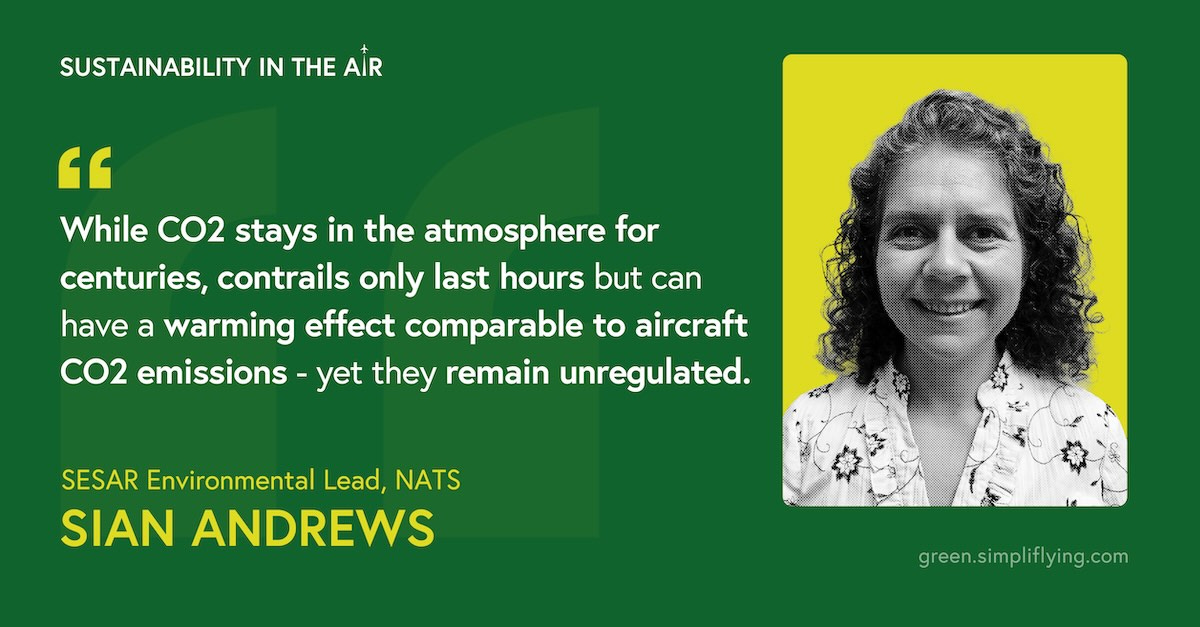In this episode of our ‘Sustainability in the Air’ podcast, Shashank Nigam, CEO of SimpliFlying, speaks with Sian Andrews, SESAR Environmental Lead at NATS, UK’s leading provider of air traffic control services. She shares insights into how air traffic management can significantly reduce aviation’s environmental impact through innovative solutions and research projects.
“We are the UK’s leading provider of air traffic control services,” explains Andrews. “Our function as an air navigation service provider is to ensure the safe flow of air traffic and make sure that flights can be as efficient as possible while ensuring their safety.”
Here are the key highlights of the conversation:
NATS’ role in air traffic management (2:12)
How NATS’ research is helping reduce carbon emissions (4:10)
The environmental impact of contrails (12:20)
Green route charging concepts (20:55)
Managing fuel efficiency and contrail avoidance (25:20)
Balancing safety and efficiency with environmental concerns (31:20)
Promising future innovations (37:03)
Rapid Fire! (39:40)
Keep reading for a detailed overview of the episode.
How big a problem are contrails for aviation sustainability?
Condensation trails, also known as contrails, are long, thin clouds that often form behind an aircraft in cold and humid conditions when water vapour freezes around small dust and soot particles from the engine. Although they look harmless, contrails are made up of small ice crystals that can trap heat in the Earth’s atmosphere and contribute to global warming.
While much of the aviation industry’s focus on sustainability centres around future technologies like hydrogen aircraft and sustainable aviation fuels, the immediate impact of contrails presents both a challenge and an opportunity.
Data suggests that contrail effects, though short-lived, could be comparable to aviation’s CO2 emissions in terms of warming impact.
For example, one study found that contrails cause 57% of aviation’s warming impact.
Another report by the IPCC in 2022 noted that contrails account for roughly 35% of the warming impact.
Through the CICONIA project, led by Airbus and involving NATS, researchers are developing operational solutions for contrail avoidance while balancing fuel efficiency and air traffic management constraints. The project aims to demonstrate that relatively small operational changes can yield significant environmental benefits.
4 takeaways from the conversation
1. CICONIA project and NATS’ research into contrail avoidance
The CICONIA project is a SESAR (Single European Sky ATM Research Project) initiative led by Airbus, with NATS playing a crucial role in researching and implementing contrail avoidance strategies.
The project is structured around four main work packages, as Andrews explains: “Two focus on scientific aspects, including MET forecasting and climate impacts, with expert involvement. The other two focus on developing operational concepts and conducting validation workshops to demonstrate feasibility.”
Within the project, NATS focuses on trialling potential air traffic management methods over the North Atlantic, developing pre-flight planning protocols, and exploring airspace reservation strategies. Using computer simulations, they analyse performance across different scenarios while considering factors such as air traffic constraints, fuel efficiency, and safety requirements.
The initiative seeks to demonstrate that immediate action is possible without waiting for new technologies, as Andrews emphasises:
“We think it is possible to do something [about contrails] and to really make some improvements. We don’t have to wait decades for new technology to come out so that we can implement those improvements.”
2. Green route charging
NATS is also seeking to tackle environmental inefficiencies through the Green GEAR project, which examines how current pricing structures sometimes incentivise airlines to fly longer, less fuel-efficient routes.
Andrews explains the paradox:
“Although they're spending more money to burn more fuel and emit more CO2, they are actually having a slightly cheaper flight because those air traffic charges are less.”
The proposed solution includes origin-destination charging, where costs would be based on the direct distance between airports rather than the actual route flown.
However, implementation presents significant challenges. “Although it seems simple... politically, that’s quite difficult because certain airlines have certain routes that would be more effective than others,” Andrews notes.
3. The Digital European Sky initiative
The Digital European Sky represents a comprehensive transformation of Europe’s aviation infrastructure, first proposed by the SESAR Joint Undertaking in 2017. This initiative aims to modernise air traffic management (ATM) systems to handle increasing air traffic safely and efficiently while minimising environmental impact.
Rather than a single project, Andrews explains,
“It’s effectively a collection of the solutions that we're researching through SESAR that will come together to form the Digital European Sky.”
This collection of solutions addresses multiple aspects of ATM, from arrival streaming to non-CO2 mitigation strategies.
Taking a holistic, passenger-centric approach, the initiative brings together all key stakeholders – airports, airlines, air navigation service providers (ANSP), and regulators – to create an agile system capable of handling future growth and diverse air vehicles.
It shows how multiple small improvements can combine to create significant environmental benefits, and includes advanced weather forecasting systems for contrail prediction, trajectory prediction tools, cross-border coordination systems, and sophisticated traffic flow management tools.
4. Balancing safety and sustainability
ANSPs face the challenge of balancing environmental considerations and efficiency with safety. NATS’ approach demonstrates that safety and sustainability can go hand-in-hand, particularly in fuel efficiency and optimal flight paths.
To achieve this balance, NATS developed the three-dimensional insight (3Di) environmental performance metric. Introduced in 2012, 3Di helped NATS become the first air traffic service provider to be financially incentivised based on environmental performance, and has also led to savings of over 6 million tonnes of aircraft CO2.
The metric works by comparing actual aircraft trajectories against optimal flight paths that would minimise fuel burn and CO2 emissions. A ‘perfect flight’ (scoring zero) would include:
Continuous climb to optimal cruise altitude,
The most direct possible route,
Continuous descent to touchdown,
Optimal flight level throughout.
Deviations from this perfect profile – such as holding patterns, stepped climbs/descents, or suboptimal flight levels – increase the score. NATS faces financial incentives based on annual 3Di targets, earning bonuses for beating targets and penalties for falling short.
As Andrews explains:
“We’re one of the few, if not maybe the only ANSP that’s actually regulated on our environmental performance... If we do well, we’ll achieve a bonus. If we don’t, there will be a penalty.”
‘Sustainability in the Air’ is the world’s leading podcast dedicated to sustainable aviation. Through in-depth conversations with top aviation leaders, we break through the clutter and provide a clear roadmap for a net-zero future.
For October 2024, we’re pleased to feature SITA as our exclusive Sponsor of the Month. SITA is a global IT provider for the air transport industry, helping airlines navigate complex environmental regulations. Discover how their Eco Mission tool can simplify compliance, reduce costs, and provide real-time insights to support your sustainability goals.













